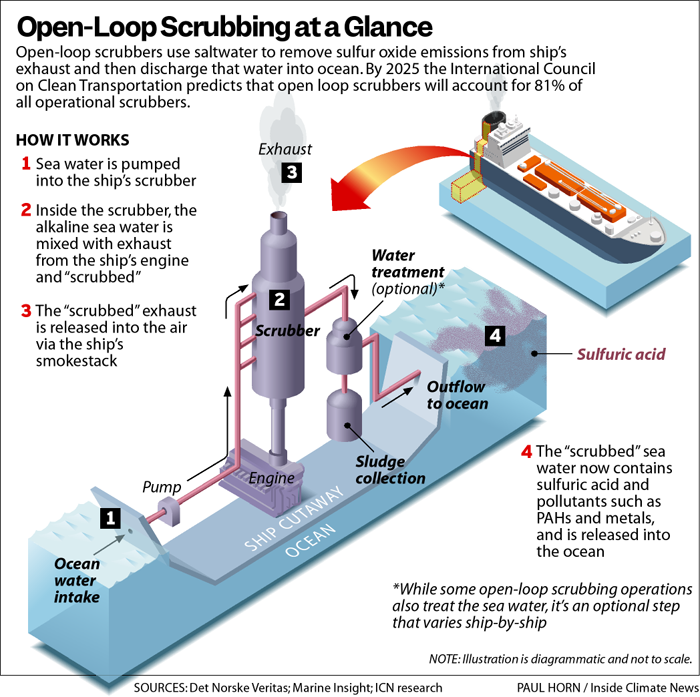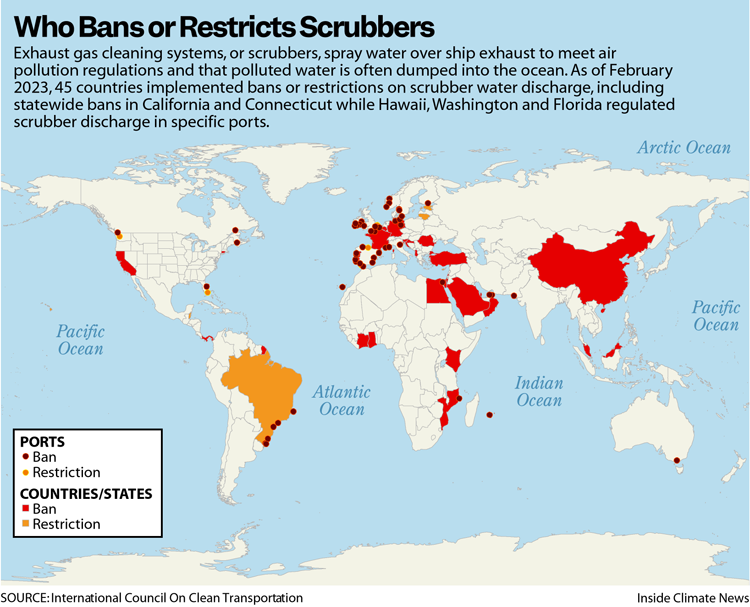A Shipping Rule Backfires, Diverting Sulfur Emissions From the Air to the Ocean
In 2020, an international rule went into effect that sharply reduced the amount of sulfur allowed in ship fuel. The aim was to rein in atmospheric sulfur oxide emissions, which are known to be a threat to public health and the environment.
Most ships have complied with the three-year-old sulfur cap, imposed by the United Nations’ International Maritime Organization, by switching from tar-like heavy fuel oil to cleaner, less polluting fuels. But the IMO also allows the countries where merchant vessels are registered to certify “alternative mechanisms” to comply with the cap.
One is the exhaust gas cleaning system commonly known as a scrubber, which treats the pollution that normally would go into the air—and then dumps it in the sea.
In a new study, researchers report that guidelines created last year by an IMO committee to assess the environmental risk from scrubber discharge are woefully inadequate, resulting in the release of water with multiple pollutants that jeopardize marine environments.
In essence, they say, an effort to protect the earth’s atmosphere has proved to be a threat to its seas. “The problem here is that the goals were only focusing on the air emissions,” said Anna Lunde Hermansson, a lead author of the study. “And what we’re showing now is that that has an effect on the marine environment because you’re actually just shifting your emissions from air to water.”
The study was published in the Marine Pollution Bulletin, an international scientific journal.
Researchers point out that the risk extends beyond commercial harbors, where countries have the option of regulating scrubber water discharge. “All of these contaminants are also transported out of the ports to pristine areas,” Lunde Hermansson said.
The study harnessed ship traffic and emissions data from previous studies on scrubber water for the Baltic ports of Copenhagen and Gdynia, Poland, as well as two theoretical ports generated by computer modeling that are used for environmental risk assessments.
A Panoply of International Regulations
Scrubbers, connected to a ship’s exhaust piping, work by spraying water over the engine exhaust to dissolve sulfur oxides and other contaminants. The exhaust emitted is then compliant with the IMO sulfur air pollution regulations without requiring that switch to more expensive, cleaner fuels.
But often, the water is “now heavily acidified and contaminated, and that is discharged back into the ocean—normally without any cleaning steps,” Lunde Hermansson said. Some scrubber systems recirculate the water, but they still bleed off lower volumes of discharge with much higher concentrations of contaminants.

Lunde Heramansson and her colleagues wanted to better understand the cumulative environmental effect of various toxic metals and organic compounds from scrubbers and other systems on ships that can emit the same pollutants. Because guidelines set by the IMO’s Marine Environmental Protection Committee deal only with scrubber water, the researchers set out to examine contaminants released by other systems aboard the ships as well.
“That was kind of the background for this entire study,’’ Lunde Hermansson said. “We want to look at more than one substance at a time because marine organisms are affected by several substances at the same time.”
Pollution from shipping is regulated under a variety of umbrellas. Different sources of waste and contaminants such as sewage, ballast water and the paint that prevents marine organisms from growing on the ship, known as biocide paint, are all policed separately. The 2022 guidelines approved by the IMO’s Marine Environmental Protection Committee are not a binding requirement like the 2020 sulfur cap, but rather intended to guide member states in drafting and enforcing their own rules for scrubber water discharge.
Lunde Hermansson said the guidelines were a step in the right direction. Still, she noted that they only assess the environmental risks for scrubbers and do not take other systems on ships that emit pollutants into account.
The guidelines also say that countries should base their pollution risk assessments on the environment surrounding the ports rather than the immediate discharge site—another shortcoming, in her view. Not only does this suggest that the port itself isn’t worthy of protection, Lunde Hermansson said, but it ignores the fact that the waters outside the port are broader and deeper, meaning the concentrations of pollutants will always be significantly lower there.
And without also accounting for emissions coming from other areas, “essentially, everything would pass a risk assessment if you use the strategy.” Lunde Hermansson said.
Consequently, the amount of scrubber discharge allowed in these ports is often very high.
The IMO said in a statement that it does not comment on specific studies.
Researchers estimated the emissions of nine metals and 16 PAHs, or polycyclic aromatic hydrocarbons, organic compounds that are formed by burning material like coal, gas or oil and are known to be toxic to marine organisms. They then predicted the environmental concentration of each metal and PAH, using the model recommended in the IMO guidelines for environmental risk assessments of scrubber water discharge.
Combining the data from different sources of pollution on each ship, researchers were able to predict the amount of each pollutant that would be found in the port environments. They then compared this predicted amount with environmental threshold values from previous studies to calculate the risk that each pollutant presents to each of the four ports.
In Copenhagen, ships with scrubbers account for only 20 percent of the port’s estimated power consumption, and in Gdynia, 5 percent. But scrubber water often accounts for more than 90 percent of the total annual load of discharges for the metals and PAHs studied.
So while there are relatively few ships with scrubbers moving through these ports, those vessels contribute to much of the pollution there.
The researchers found that water pollution in Copenhagen and Gdynia and in a generic Baltic port generated by computer modeling exceeded the threshold for acceptable cumulative environmental risk. Of the pollution sources analyzed in the study, scrubber water and biocide paints contributed the most to the environmental risk. Biocide paint releases zinc and copper, which significantly contributes to the metal load in port waters.
Only the computer-modeled port based on Rotterdam in the Netherlands fell below the risk threshold.
“So what we can see is that if we reduce the use of these biocide paints and also ban the discharge of scrubbing water, we could reduce the contaminant load and also the risk to the ports,” Lunde Hermansson said.
And the model port that did not experience unacceptably high risk from shipping fuel pollutants had the highest level of water exchange for each tidal period, meaning that “all of these contaminants are also transported out of the ports to pristine areas,” Lunde Hermansson said.
Marja Koski, a professor at the National Institute of Aquatic Resources at the Technical University of Denmark, suggests that the biggest problem with scrubber water is its potent blend of contaminants and acidity.
An earlier study showed that exposure to scrubber water decreased feeding and increased mortality in copepods, small crustaceans that play a central role in marine food webs. This occurred even when the level of individual contaminants in scrubber water was lower than the accepted threshold for mortality, researchers found.
Koski contends that the immediate mortality rate is less important than the long-term effects of scrubber water on marine life and the accumulation of pollutants in the food chain. PAHs and metals persist in the marine environment, she noted. “So for that type of substance, dilution really is not any type of solution.”
An Argument Against Scrubbers
Ships equipped with scrubbers account for roughly 5 percent of ships traveling the world’s ocean but about 25 percent of the global shipping fleet’s fuel consumption. Shipping companies usually install scrubbers in their larger ships because it’s cheaper in the long run than switching to cleaner fuel.
Shipping companies started installing more scrubbers around 2015 when the IMO rolled out lower air pollution caps in specific areas of North America, the Baltic Sea, the North Sea and U.S. waters in the Caribbean that limited the amount of sulfur in fuel oil to 0.1 percent.
But the main driver for scrubber installations was the international cap imposed in 2020, which lowered the amount of sulfur content allowed in ship fuel from 3.5 percent to 0.5 percent everywhere. Over the next year, there was a 70 percent drop in atmospheric sulfur oxide emissions from shipping, according to the IMO.
Aldo Chircop, a specialist in international maritime law at Dalhousie University, said the IMO’s practice of allowing flag states to certify alternative compliance mechanisms clashes with other binding UN obligations for those countries. He asserts that the IMO tends generally not to heed or to coordinate with other UN conventions that address similar environmental issues.
Many of those states are bound by obligations to the 1982 United Nations Convention on the Law of the Sea, or UNCLOS, for example, which designates the IMO as an authority for matters concerning ship safety and marine pollution.
UNCLOS says that countries are obligated to preserve marine environments within their jurisdiction by preventing pollution. It specifically states that states cannot transform one form of pollution into another, the way scrubbers transform air pollution into marine pollution, Chircop said.
“This is a real faux pas, because the Law of the Sea Convention may not be an IMO convention, but the IMO gets a lot of its authority from the Law of the Sea convention,” he said.

While some countries draw on the IMO guidelines to draft their own legislation, others have banned scrubber water discharge in their ports and territorial waters. According to a report from the nonprofit International Council on Clean Transportation, 93 bans or restrictions on scrubber water discharge had been adopted for ports in 25 countries as of February.
In areas with restrictions, ships use a cleaner sulfur-compliant fuel or a scrubber system that does not discharge water into the ocean. Yet once they leave waters where the restrictions are in force, Chircop said, ships can switch back to using heavy fuel oil and a scrubber.
“But clearly there are more and more states that are concerned that the issue of wash water, this wastewater, is a pollutant and it is potentially harmful,” he said. “And nobody wants to harm their own marine environment. So perhaps they’re recognizing that maybe this was a mistake.”
Disclaimer: The copyright of this article belongs to the original author. Reposting this article is solely for the purpose of information dissemination and does not constitute any investment advice. If there is any infringement, please contact us immediately. We will make corrections or deletions as necessary. Thank you.







